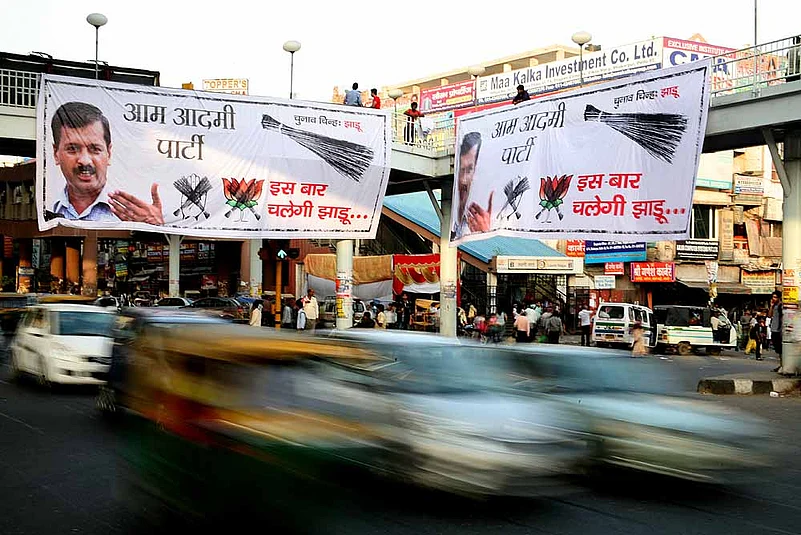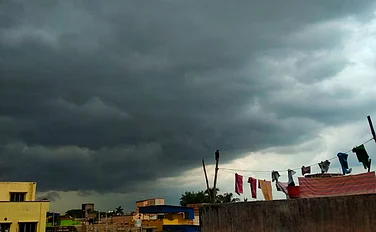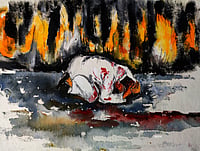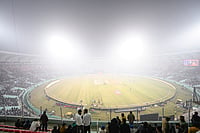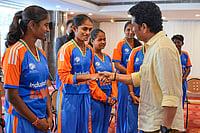Just the other day, the stand-up in Comedy Nights with Kapil, a popular TV show, came up with this one. Playing a typical cop, Kapil complains, “These days, whenever we demand money or threaten to challan someone, they only make faces like Arvind Kejriwal.” The man who styles himself as R.K. Laxman’s Common Man come to life—though an updated, knight-like version, tilting at everything with a broom in hand—has clearly caught the popular imagination. The anti-corruption and Lokpal crusader, once sceptical about politics and now in the thick of it, can at least be credited with having reshaped the political discourse as his Aam Aadmi Party takes on the ruling Congress and the BJP in the coming Delhi assembly elections.
And it’s not only the atmospherics he’s changed. If one is to believe opinion pollsters, there is a significant uptick in electoral dividends for AAP—anywhere between nine and 18 seats out of Delhi’s 70. Indeed, one of them shows a 10-seat increase for AAP from August to October and a voteshare as high as 26 per cent. That’s a bit like a wildcard entrant getting into top seeds in the initial rounds itself. What it will amount to will only be revealed in the actual test—Kejriwal, who’s the chief ministerial candidate, is firm against any coalition (see interview).
There are many sceptics. Old-school politicos, like Nitin Gadkari of the BJP, are among them. Gadkari, in charge of election work in Delhi, makes light of the buzz around AAP. “Look at the history of opinion polls. They are wrong most of the time,” he ventures. He prefers to read Delhi politics the old way, as a classic battle between two blocs.
“Not two, three,” counters Ram Achal Rajbhar, a close aide of BSP chief Mayawati and the party’s Delhi unit in-charge. The BSP has always been a strong player, and is never given its due, says Rajbhar. It’s true. Last time, the BSP won only two seats and was a close second on five. But it got 14 per cent of the vote, way higher than the margin between the Congress’s winning voteshare of some 40 per cent and the BJP’s 36. Mayawati, who draws quite a crowd in Delhi, will address a handful of rallies before the December 4 poll, where, like in 2008, the party wants to contest almost all 70 seats.
Says Rajbhar, “The media and social networks have declared AAP the third option. It’s not true. I don’t know where these projections are coming from. We have been around as the third option for quite some time. We have our core voters plus the support of sarvasamaj.” Tickets will be finalised before Diwali. But those who have a clear hint from the party are already in campaign mode.

BJP show There’s infighting in Delhi unit. (Photograph by Jitender Gupta)
In the Congress, there is a nervous awareness that it won’t be a cakewalk. Chief minister Sheila Dikshit, all of 76, completes three terms in office, helped by her old aura of an efficient grandmother administering a school or trust. Of late, that endearing, homely image has suffered. Corruption in the Commonwealth Games (CWG) is what soured the long consensus around her. Then other issues started getting aired. Problems in slum resettlement, regularisation of unauthorised colonies, inflated utility bills, and most of all, rising prices. Spectacular cases of crime hastened the loss of lustre—with people unwilling to swallow the separation of police jurisdiction as a valid excuse. As it is, the poor reputation of the UPA-II at the Centre has coloured people’s perception of Sheila’s tenure.
AAP, which originally precipitated this rising demand for accountability in government and the mood of low tolerance for corruption, is now a direct rival. And adding to the anti-incumbency tide is an economic gloom, the grating uncertainties of daily life. But Sheila is unfazed. “In 2003 too, they spoke of anti-incumbency,” she says. “Again in 2008, after the sealing drive. Now, when Delhi has more development, more flyovers, more welfare schemes, the Metro, you repeat the same thing—anti-incumbency. Believe me, we are coming back to power.”
The usual shambolic scene outside the Congress office offers some contrast to this picture of forced composure. Wannabes in warring camps are shouting slogans and trading charges against each other. Eager to expose each other, each claims to be working on the “directions of Rahulji”. Sheila wanted all 42 sitting MLAs to contest again but questions were raised about some of them. It is understood that Sheila got so annoyed that she asked the committee to keep her own candidature on hold.
The only consolation for the Congress may be the state of the BJP. Out of power since 1998 and beset with serious infighting, prima facie it seems a spent force. But there are two unknown variables which, if they act in concert, can swing things its way. One is the much-touted urban appeal of Narendra Modi, which can surely mop up some undecided votes and firm up its bottomline. At the same time, if AAP cuts into the Congress coffers by spiriting away some disenchanted voters, it might be game on for the BJP.
They are of course loath to give any credence to the fresh entrants. “They are vote katwa,” says BJP man Sudhanshu Mittal. “Everybody knows Sandeep Dikshit (Sheila’s MP son) and Kejriwal are friends. The Congress is helping them so they will soak up the anti-incumbency votes (that otherwise would go to the BJP). But people are wise to it.”
But the fact is AAP has changed the climate in which even the BJP makes its decisions. The party is not yet projecting a chief ministerial candidate for Delhi, though Modi has been declared its PM candidate for 2014. There are four claimants: Vijay Goel, V.K. Malhotra, Vijender Gupta and Harshvardhan. The burst of sudden hype this week over the possibility of projecting a relatively ‘clean’ Harshvardhan stems from this. The man himself downplays it: “People want change: 15 years is a long time for a party that has been blundering along.” But the infighting is such that Gadkari had to be brought in to eke out a consensus. Gadkari, of course, denies any rift. “The rumours of internal strife are wrong,” he says. “We know victory will be ours. The CM will be decided only after the polls.”
But it’s well known that the state unit, before Gadkari was brought in, was in the control of Goel. He does not miss a chance to claim he’s the party’s chief ministerial candidate. In its campaign, the AAP too targets Goel as the BJP’s CM-hopeful. “Who else?” says Goel with a smile, when this is pointed out to him. “I’ve been leading the state unit for years.” But a direct question—Are you the CM candidate?—evokes a non-committal “I can’t say that.” Declaring a CM candidate now could invite rebellion, direct or passive, and the party would pay a heavy price. The candidate list isn’t ready, and some say it isn’t likely to happen soon. The fact that Goel is an Advani campwallah who’d earned the ire of Modi is significant too.
The AAP, meanwhile, is learning to handle realpolitik—tickets for backwards, women, Muslims and Sikhs, but candidates have to pass a stringent cleanliness test. “There is no second thought about the mandate in the state; AAP is gaining more popularity on a daily basis. We’re going to form the government and Kejriwal is going to be the next CM of Delhi,” says Prashant Bhushan, frontline leader of the AAP.
But what if they get fewer seats? “Kejriwal has already declared that AAP will sit in opposition instead of allying with any party. What if the elections throws up a hung verdict? It’s not going to happen. If it does, the BJP and the Congress will negotiate on their share of loot and form the government,” he says.
The parties are throwing up their own predictions, but the fact of there being many sides—Congress, BJP, BSP, AAP—is leaving everyone confused about how the votes will stack up. Behind the dismissiveness, both the Congress and the BJP are forced to work their strategies and campaigns around those of the AAP.
And independents are bound to play a crucial role; the ncp and the BSP have decided to contest from all seats too. So the politics of caste, religion and regional identities (the state has many migrant populations) is bound to come into play. Modi’s recent rally in Delhi has also “made a considerable impact”, according to the BJP; the results will also give part answer to how much influence he holds outside Gujarat. The BJP is keen to prove a point in Delhi and Rajasthan, both Congress-ruled states, ahead of 2014. Congress leaders admit they may end up with fewer seats, but are confident they will retain power in both.
How do ordinary folks see it? “With BJP, Congress and AAP seeking votes, it’s confusing,” admits Rakesh, a rickshaw puller in Chandni Chowk. “I don’t want to vote for Sheila, but who else would be the right choice?” asks Harsh Kumar, a bank employee. “Do you think AAP could make it? And how is the BJP different?” Sceptics like him form a big number, people who see AAP is different, but suspect it will eventually deteriorate the way all parties do. It’s this sentiment that might ultimately help the big parties.
Says journalist Arvind Mohan: “There is an anti-Congress wave. Underestimating AAP could be bad mathematics...if 10 lakh signatures, 2 lakh volunteers is true, they have potential.” So it looks like the third player holds the key.
***
Political Parties In Delhi
Through its vigorous campaign, the Aam Aadmi Party of Arvind Kejriwal has emerged as a strong factor. How do the established parties—the BJP and the Congress—measure up?
Congress
| Challenges | Strengths | |
|
| |
BJP
| Challenges | Strengths | |
|
| |
AAP
| Challenges | Strengths | |
|
| |
By Panini Anand in New Delhi






